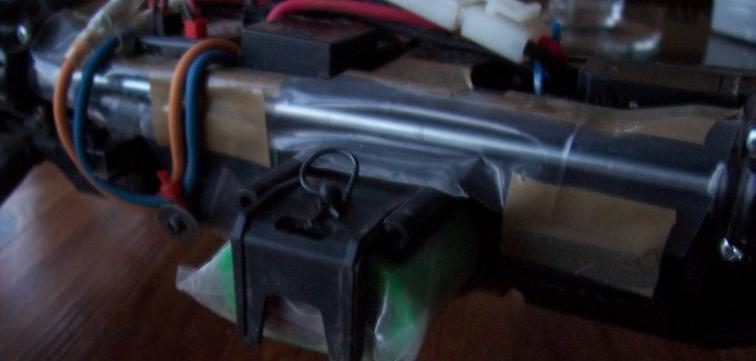The Baja King bodyshell
There are two methods for painting the lexan body: cutting and then painting, or reverse. I chose the second one which seem better as it avoids paint projections on the body. Because the paint must be applied from the inside.
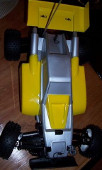

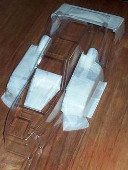 Always start with the darker color (here silver, then yellow). Otherwise, the lighter color will be affected by the darker.
Always start with the darker color (here silver, then yellow). Otherwise, the lighter color will be affected by the darker.
Anyway, prior to apply the silver, you have to hide the parts that will be painted yellow. This is not the easy part of the job since the body is not plane at all (the body perfectly molds the chassis). Two layers of silver paint later, it needs to dry for 24 hours. Then, it's time to remove the masks and to apply the yellow paint.
Removing masks should be done slowly and with caution.
Final steps: cutting the body and piercing body mounts holes.
Assembling the TL-01B chassis
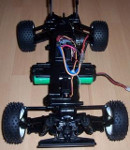


First step is the assembly of the differentials and gearboxes: unlike the Blackfoot Xtreme, they are not pre-built.
Much better for replacing plastic bearings with ball bearings. Next step is to attach the gearboxes (front and rear) to the chassis frame, including the propeller shaft.
As for dampers, I directly fitted optional hydraulic ones.
The built is quite easy, just slightly harder than the Blackfoot Xtreme's. The main reason is that there is less room inside this chassis. Everything fits perfectly, but there is almost no room left.
Well, until I noticed a problem: the front wheels were rubbing against the uprights. Very surprising for a Tamiya model.
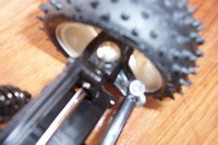

So, I asked for help on forums: soon it becomes obvious I made a mistake. The uprights I assembled are for the on-road version of the chassis. Off-road version are provided in the box with the motor: that's why I didn't see them because I left the stock motor to use a better one (the Sport Tuned).
Quick disassembling, then I fit the correct uprights: they fit perfectly and front parallelism is now correct (as per magic ![]() ).
).
That's it, the chassis assembly is finished. Electronics are installed and cables are tied. The electronic speed controller still needs to be set up: very easy, it's done within a minute. Last step: adjusting the steering trim.
I couldn't resist to test this new model. Slowly going in the apartment shows everything is fine. Even tires marks on the floor indicate the motor works very well.
I was amazed by the suspension travel of this buggy: the ground clearance is quite low thought. On the playground, the buggy will probably get stuck on its chassis if I would ever try to crawl some rocks (well, I won't). On pictures below, the 4 wheels touch the ground naturally (ie I didn't press the chassis on the ground).
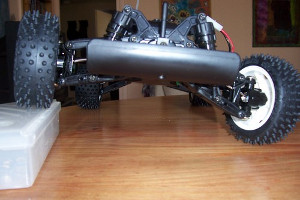
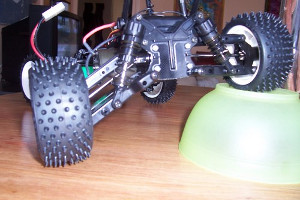
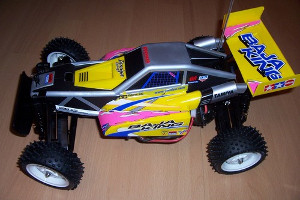
The Baja King is now finished! There are some paint mistakes due to the masking tape which is not 100% efficient. Stickers hide most of them anyway. For decoration as for colors, I decided to stay "box art", the "official" scheme Tamiya decided for this model. Now I look forward to the first run!
Several modifications on the TL-01B chassis
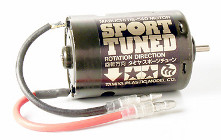

As previously mentioned, I decided to include some options directly during the assembly. Hydraulic shock absorbers replace the stock friction models (those are just slightly better than springs), and a 23 turn Sport Tuned motor replaces the stock Mabuchi 540. Not to mention ball bearings everywhere.
According to several reviews, this buggy speeds up by 5 km/h when it is fully ballraced (from 28 to 33 km/h with the stock motor). With the Sport Tuned motor fitted, my Baja King should be close to 40 km/h at top speed.
No specific protection for electronics at the moment. The chassis layout is very different from the Blackfoot Xtreme's, so I will have to consider a new approach, if needed.
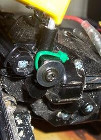
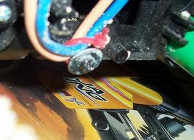
However, I have already made a few changes. The first one it to have the cables better tied: I fitted a spacer and a screw on the chassis, then I used a cable tie to fix the motor cables. I made a second mod to improve the antenna pipe stay because it used to detach from chassis too often.
Cleaning the buggy after the first run took a while: dust, pebbles, mud, everything is spread all over the chassis by the front wheels. In particular an impressive amount of pebbles at every corner of the chassis. Well, this chassis was first designed to run on-road and this version is adapted to off-road purposes. Indoor, this problem does not exist...
That's why I decided to install a few protections to avoid pebbles to block mechanics, including the propeller shaft which is very exposed. The smallest pebble could block it and severely damage the whole transmission and the motor.
I simply used a cut tree bag and scotch to wrap all around the propeller shaft. Yes it is ugly, but it deserves its purpose. With the bodyshell on, you can't hardly notice it.
I also wrapped the battery pack: its housing is very tight but I found pebbles inside and they scratch the cell envelope when you try to remove it. In practice, the problem remains: so I tested another method by taping each side of the battery pack at chassis exit. It is much better as no more pebbles go inside.
